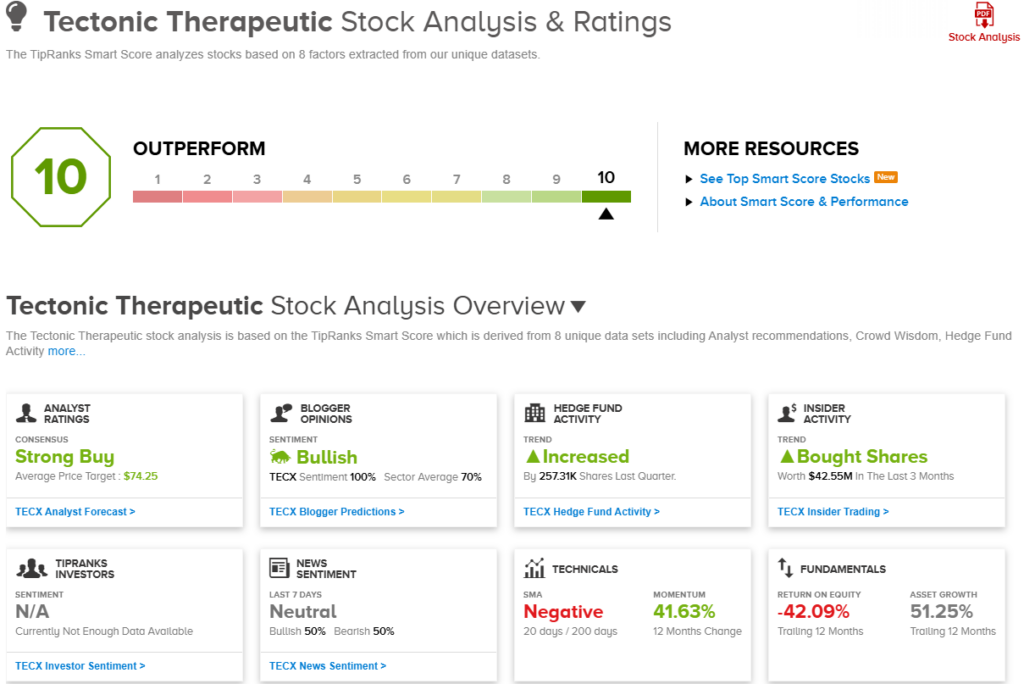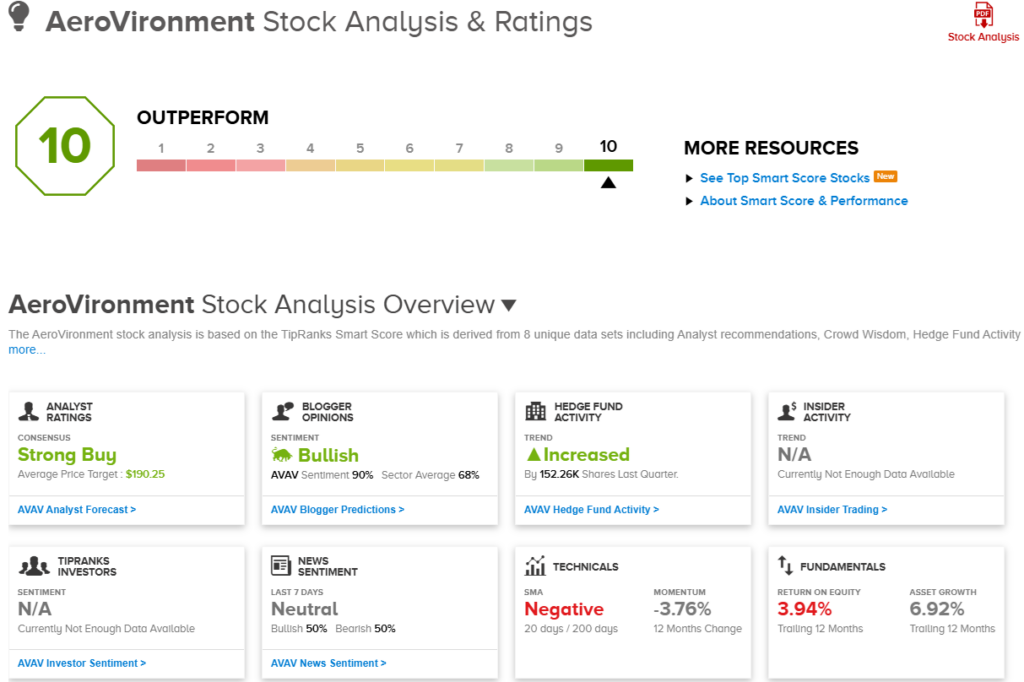Building a strong portfolio naturally hinges on choosing the right stocks. The tricky part? Finding them. With thousands of publicly traded companies and a flood of investment ‘methods’ floating around, it’s no wonder even seasoned investors can feel overwhelmed.
The biggest problem with sorting through that array of stocks comes from the sheer volume of data that needs to be examined. Those thousands of stocks are traded by thousands of investors – and there are tens of millions of daily transactions, every one of which adds another bit to the flow of raw market data. No human can keep up with that kind of volume – but AI can.
That’s where TipRanks’ Smart Score steps in. This powerful algorithm, built on AI and natural language processing, cuts through the chaos. It sifts through vast amounts of market data, analyst insights, and technical indicators, distilling it all into a simple, actionable rating. Every stock gets a score from 1 to 10 – based on factors statistically tied to future outperformance – making it easier than ever to identify potential winners and sidestep the duds.
The ’Perfect 10’ scores indicate stocks that definitely deserve a closer look. We’ve opened up the database at TipRanks to find out what Wall Street thinks of 2 top-scoring stocks; here’s a closer look.
Tectonic Therapeutic (TECX)
The first ‘Perfect 10’ stock we’ll look at here is a biopharmaceutical research firm, Tectonic Therapeutic. Tectonic is working at both the preclinical and clinical stages, focusing its efforts on the development of G-Protein Coupled Receptors, or GPCRs, into a line of new drug candidates. GPCRs have an important role, as receptor molecules, as regulators in several human biological functions. They appear on cell surfaces and are actively involved in regulating such vital functions as blood pressure regulation, glucose metabolism, immune function, and neuronal signalling. Molecules with such varied actions in the human body are bursting with potential for medical research – and Tectonic is working to unlock that potential.
The company has created a proprietary drug development platform, dubbed GEODe, which it uses in its discovery efforts for new biologic medicines to add to its research pipeline. Currently, Tectonic has several lines in the preclinical discovery stage, and one, TX45, in the human trial clinic.
TX45 is under investigation as a potential treatment for high blood pressure in the circulatory system of the lungs, a dangerous condition known as pulmonary hypertension. The drug candidate is an ‘Fc-relaxin fusion protein,’ with potential to become the best in its class, and Tectonic is studying its efficacy in the treatment of Group 2 pulmonary hypertension. The drug’s action leverages vasodilatory and anti-fibrotic properties of relaxin.
Tectonic has had some success with TX45 in the clinical studies. In September of last year, the company released favorable data from the Phase 1a study, and in January of this year it followed that data with another set of favorable interim results, on the Phase 1b stage of the study, in patients with Group 2 pulmonary hypertension in HFpEF. This coming May, the company will present additional Phase 1b data to the European Society of Cardiology (ESC) Heart Failure 2025 Congress. The drug is currently undergoing a Phase 2 clinical trial, with results expected next year.
We should note that, despite these successes in the trial clinic, shares in TECX are down 56% so far this year. The stock’s decline began in January, after the pharma giant Eli Lilly terminated the clinical studies of its kidney disease drug candidate volenrelaxin. The termination was due to concerns that the drug was not proving efficacious; the negative impact on TECX shares came because volenrelaxin is in the same class of drugs, relaxin mimetics, as TX45. The failure of volenrelaxin has caused analysts and investors to worry about the efficacy of Tectonic’s lead candidate – worries that only a series of positive trial results will allay.
Despite concerns surrounding the broader relaxin drug class, Mizuho analyst Uy Ear sees substantial promise in the company’s TX45 candidate and argues that the market is drastically undervaluing its potential.
“We like TECX as we believe: (1) The stock price reflects near zero value for TX45, which we believe has $3.3B unadjusted/$1.2B adjusted peak sales potential in CpCPH with HFpEF alone. There are also multiple scenarios for TX45 to treat the larger Group 2 PH, which would lead to significant upside; (2) While there are concerns about the ineffectiveness of the relaxin class, we see limited read-through from Lilly terminating volenrelaxin’s Phase 2 for futility, given the different conditions (heart failure vs TX45’s Group 2 PH) and continued validation of the MoA from AstraZeneca’s ongoing AZD3427 Phase 2 in Group 2 PH; (3) The consistency and clinically relevant magnitude of the improvements — left ventricular function and pulmonary hemodynamics — observed in the Phase 1b hemodynamic data will likely translate to clinical benefit in PH-HFpEF; and (4) Strong cash position (~$326M in 1Q25) with runway into 4Q28 and to complete the Phase 2 trial for TX45 and the Phase 1 and Phase 2 trials for TX2100, provide additional potential catalysts for the stock,” Ear opined.
With that, Ear rates the shares as Outperform (i.e., Buy) and sets a $51 price target—implying the stock could soar by 152% over the next year. (To watch Ear’s track record, click here)
Overall, there are 5 recent analyst reviews of this stock, and they are all unanimously positive – giving TECX shares a Strong Buy consensus rating. The stock’s $20.23 trading price and $74.25 average target price together suggest a hefty 267% one-year upside potential. (See TECX stock forecast)

AeroVironment (AVAV)
The second ‘Perfect 10’ we’ll look at here is a defense contractor, AeroVironment. This company, which was founded in 1971, has a historical specialization in applied robots, in the form of unmanned aerial vehicles (UAVs) and uncrewed aircraft systems (UASs) – that is, drones. Today, AeroVironment has moved beyond drone aircraft and, in addition, designs and produces unmanned ground vehicles (UGVs) and high-altitude pseudo-satellites (HAPS). These lines of uncrewed vehicles are designed to give military users superior reconnaissance capabilities without risking human crews. In a more offensive-minded design, the company also produces loitering munition systems (LMSs), capable of hovering over a battlefield and providing both offensive and defensive fire support.
AeroVironment focuses on giving its customers ‘solutions that work,’ based on the bedrock fact that there is minimal margin for error in most military applications. The company takes part in every aspect of product development, from the design and production of prototypes to the deployment of regular production models. AeroVironment is always looking for ways to improve the ease of use and effectiveness of its drone aircraft and vehicles.
In recent weeks, AeroVironment has made several important expansionary moves. Probably the most important of these is the April 1 stockholder approval of the company’s acquisition of Blue Halo. Blue Halo is a defense contractor working in various high-tech fields, including directed energy weapons, electronic warfare, AI, and counter-measures to uncrewed vehicles and aircraft. AeroVironment’s acquisition of Blue Halo is valued at $4.1 billion, as an all-stock transaction.
In addition, AeroVironment has scored two important European contracts in recent weeks. In March, the company was awarded the contract to deliver 41 large uncrewed ground vehicles to the German military, with deliveries running from summer of this year into 2027. And on April 21, AeroVironment announced it had won a $46.6 million contract with the Italian Defense Ministry to deliver the JUMP 20 vertical takeoff and landing (VTOL) medium uncrewed aircraft system. The five-year contract includes delivery of the drone aircraft, as well as engineering services and initial sustainment and technical support.
On the financial side, AeroVironment missed the forecasts on both revenue and earnings in its last report, which covered fiscal 3Q25. In that quarter, which ended on January 25, the company had a top line of $167.6 million, down 10% year-over-year and falling short of the analysts’ forecast of $188.2 million. At the bottom line, AeroVironment’s non-GAAP EPS of $0.30 was 36 cents per share less than had been anticipated. Looking forward, however, AeroVironment reported having a funded backlog of $763.5 million as of January 25; this figure was a company record.
For Raymond James analyst Brian Gesuale, the key here is this company’s ability to disrupt the defense industry. He is impressed by the Blue Halo transaction, too, and writes of AeroVironment, “We see ~15% upside to consensus estimates over NTM, see valuation as compelling, and believe the standalone AVAV as well as its pending acquisition of Blue Halo position it as one of the elder statesmen of the Defense Disruptors. This cohort that includes Anduril, Palantir, Shield AI, and several other non-traditional defense names is poised to take significant share in the growing DOD budget over the next decade.”
Gesuale rates AVAV shares as a Strong Buy and he complements that with a $200 price target, implying a one-year gain for the shares of 30.5%. (To watch Gesuale’s track record, click here)
As with TECX above, there are 5 recent reviews on record here and they are all positive – for a unanimous Strong Buy consensus rating. AVAV stock is priced at $153.24 and its $190.25 average price target suggests a 12-month upside potential of 24%. (See AVAV stock forecast)

To find good ideas for stocks trading at attractive valuations, visit TipRanks’ Best Stocks to Buy, a tool that unites all of TipRanks’ equity insights.
Disclaimer: The opinions expressed in this article are solely those of the featured analysts. The content is intended to be used for informational purposes only. It is very important to do your own analysis before making any investment.
















